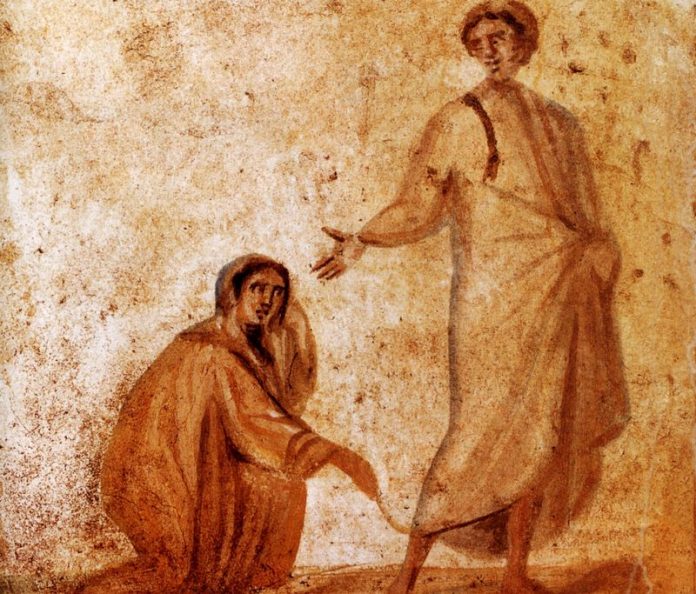
Keeping the Eucharist central to our catechesis
WILLIAM O’LEARY
While attending a conference last July, I was reminded of the Gospel account in Mark about the healing of the woman who had been suffering with a hemorrhage (see Mark 5:25-34). She believed that if she just touched the tassel of Jesus’ cloak, she would be healed. What motivated her? Faith in Jesus and a desire, longing, and hope in the healing power that Jesus could provide. Her soul was pregnant with faith, hope, and love. The original hardbound first edition of the Catechism used an ancient fourth-century image from the catacombs (see above) to illustrate how this passage represents the whole life of the liturgy and sacraments. Underneath the image in the second pillar of the Catechism, it states:
The Sacraments of the Church now continue the works which Christ had performed during his earthly life (cf. CCC, 1115). The sacraments as it were are “powers that go forth” from the Body of Christ to heal the wounds of sin and to give us the new life of Christ (cf. CCC, 1116).
At that same conference, there was a time of Exposition of the Blessed Sacrament during which I experienced something akin to what the woman with the hemorrhage did. Jesus was carried in the monstrance through a crowd of more than 600 adults, and if you were close enough, you were invited to reach out and touch the humeral veil of the priest. I experienced a real sense of wonder surrounding Jesus and a personal longing to just touch him, reach out to him, and give praise and adoration to him. This was a moving experience for all those present — one example of lives that are not only devoted to the Eucharist but in love with Jesus Christ.
The Gift of the Eucharist
The Holy Eucharist is a perpetual gift. The Church safeguards the tradition of celebrating the Holy Eucharist daily around the world so as to make Jesus accessible. The Catechism echoes this when it states that daily life weakens our sense of charity, and the Eucharist strengthens the virtue of charity in us (see CCC, 1394). The gift of the Eucharist is of the utmost importance for the fruitful participation in the Christian life. When St. Teresa of Calcutta was organizing her new community, the Missionaries of Charity, she wrote to the Archbishop of Calcutta about how vital the Eucharist would be to her sisters. She said:
“The work that we will have to do will be impossible without His [Jesus’] continual Grace from the tabernacle. He will do everything. We have just to follow.” (Letter from the Loreto Convent, Calcutta, January 28, 1948)
Another witness to the gift of the Eucharist is the Curé of Ars (St. John Vianney). He spoke of the Eucharist constantly in his preaching and teachings. The closer he was in proximity to the Eucharist, the more he wanted to talk about Jesus. One year during preparations for the Corpus Christi procession, some boys were rehearsing their role of throwing rose petals before Jesus in the monstrance. St. John’s Eucharistic meditations recount how he came up to the boys and said, “When you throw flowers before the Blessed Sacrament, my boys, hide your hearts in your baskets, and send them to Jesus Christ, among the roses.”
The Privileged Place of Encounter
Name a place where the crowds come daily, especially Sunday, to encounter Christ. Every Catholic church offers this place of encounter — not just spiritually, but in a concrete manner. Why do thousands of people faithfully come to Sunday Mass each week? It’s profound but simple: They want to be touched by Jesus; they want to encounter the God who loves them. This is why Mass is so central to the Christian life. It is the place Christ is most fully encountered. Mass is that place where Christ is encountered through his Word, in the priest, in the community, and most especially in the bread and wine that becomes the Body and Blood of Christ. The Eucharist we receive at every Holy Mass can be an authentic and personal encounter with Jesus Christ. The Catechism says:
“The liturgy is the summit toward which the activity of the Church is directed. it is also the font from which all her power flows.” It is therefore the privileged place for catechizing the People of God. “Catechesis is intrinsically linked with the whole of liturgical and sacramental activity, for it is in the sacraments, especially in the Eucharist, that Christ Jesus works in fullness for the transformation of men.” (CCC, 1074)
The liturgy, therefore, is the privileged place of encounter with Christ (see CCC, 1153). Are we communicating and helping children, young people, and adults actually find this to be true for themselves in our parishes? The more we can foster this, the more Christ’s disciples (i.e., us) will be joined to him. Our catechesis must connect the people of God to the liturgy and foster an encounter with Jesus in Holy Communion. Isn’t that powerful? The Church confirms this when she teaches: “The whole liturgical life of the Church revolves around the Eucharistic sacrifice and the sacraments” (CCC, 1113). These are the very roots
of the Christian life.
As a result of our conviction of the reality of the Eucharist, we must point, reference, connect, link, and bring people to the font from which all her power flows. We are called in our catechetical ministry to direct and foster the liturgical and sacramental life to be a constant place of encounter with Jesus Christ himself — personally and concretely. Blessed John Henry Newman wrote about what our approach to participating in the Mass should be when we develop the appropriate disposition. He said:
To me nothing is so consoling, so piercing, so thrilling, so overcoming, as the Mass. … I could attend Masses forever and not be tired. It is not a mere form of words — it is a great action, the greatest action that can be on earth. (See John Henry Newman, Loss and Gain: The Story of a Convert, pp. 327-328. London: Longmans, Green, and Co., 1906)
How do we develop attitudes and form a Eucharistic culture in our parishes?
Here are some suggestions for how religious education, Confirmation, middle school, RCIA, and adult faith-formation programs can foster a Eucharistic culture in the parish:
1. Understand the essential link between catechesis and the sacramental life. Liturgy without catechesis turns into hollow ritualism, and catechesis without liturgy turns into rationalism.
2. Cultivate opportunities where children, youth, and adults can spend time with Jesus in Eucharistic Adoration. Venerable Archbishop Fulton Sheen has a very inspiring story that can be found on the internet about an 11-year-old girl whose devotion to the Eucharist inspired him to make a personal commitment to spend an hour a day in Eucharistic Adoration. A Catholic church is more than simply a gathering space for public worship. It is a place of encounter with Jesus in the tabernacle on a round-the-clock basis. Our programs should not just talk about Eucharistic Adoration; they should help people experience it.
3. Try to link any lesson to the liturgy. As mentioned earlier, the liturgy is the place from which all the graces in the life of the Church flow (see CCC, 1074). For example, when talking about the commandments, we can connect them to the Eucharist by sharing that when we receive Jesus in Holy Communion we are given the grace we need to live God’s commandments. Or when talking about the Paschal Mystery, we might share how this is central to the Mass. One example is when the priest says, “The mystery of faith,” and we respond, “When we eat this Bread and drink this Cup, we proclaim your Death, O Lord, until you come again.” In that moment we are responding to what we have just witnessed — Christ becoming present on the altar. As a result, we respond by proclaiming our belief in this mystery of salvation. Connecting liturgy and doctrine in our catechesis helps us participate more fully in the mysteries we are celebrating.
4. When teaching about the liturgical year, bring people to the church. Show them the objects, symbols, and signs from the Eucharistic Liturgy, such as the sanctuary candle, altar, tabernacle, vestments, vessels, holy water, statuary, sacred art, and Stations of the Cross. A better understanding of what is regularly seen in our churches can draw them deeper into the sacred mysteries we celebrate throughout the liturgical seasons.
5. Teach the parts of the Mass as a means of encounter with God. As we share what is happening through these prayers, those we catechize will see that we are entering into a supernatural encounter with God. In his General Audience on March 7, 2018, Pope Francis said that through the Eucharistic Prayer, Christians learn three attitudes that should never be missing from Jesus’ followers:
… to give thanks, always and everywhere, and not only on certain occasions, when all is going well; second, to make of our life a gift of love, freely given; third, to build concrete communion, in the Church and with everyone. Thus, this central Prayer of the Mass teaches us, little by little, to make of our whole life a “Eucharist,” that is, an act of thanksgiving. Our catechesis should constantly draw people into God’s life and inspire us to respond to him.
6. Teach with the Lord’s Prayer. When praying the Our Father, link the petition “Give us this day our daily bread” with the spiritual food we receive at least weekly in the Eucharist. Encounter Jesus It is through the Eucharist that we most fully come into contact with Jesus Christ. God loves us with an incredible love. He has an immense desire to reveal himself personally to each one of us. The Eucharist is the primary channel. What better gifts can we ask for as we live the Christian life? His gifts are better than life (see Psalm 63:3). In St. John Paul II’s 1980 letter to the world’s bishops, Dominicae Cenae, he spoke about the great need we have today:
[T]he Church and the world have a great need of Eucharistic worship. Jesus waits for us in this sacrament of love. Let us be generous with our time in going to meet Him in adoration and in contemplation that is full of faith, and ready to make reparation for the great faults and crimes of the world. May our adoration never cease.
May our catechetical efforts foster a Eucharistic culture where we are brought more deeply into Christ’s presence and rely on him as our source of strength and joy.
William O’Leary lives in Kansas with his wife and three children. He is the Director of Religious Formation for a large parish in Overland Park, Kansas. Over the last 20 years, his work in pastoral ministry has explored ways to draw parents and their children into the practice of their faith. His blog is RelevantCatechesis.com.
This article originally appeared in Catechist magazine, November/December 2018
PHOTO: PUBLIC DOMAI




